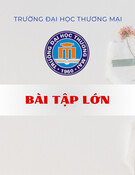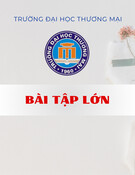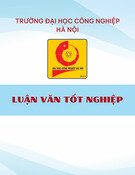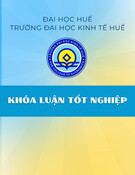Development of the Microfinance system in Russia
Anna Kaganova National Business Incubation Association Russian Federation anna_kaganova@mail.ru
Small business development in Russia
SMEs have been existing for 12 years; >5.6 millions (including 4.5 millions
of individual entrepreneurs); 90 % of the total number of establishments; 44 % of GDP; 45 % of employment.
Sources of financing Business partners, relatives or other people
Microfinancial Institutes
• convinient and especially attractive for entrepreneurs • represent a flexible form of a classical banking credit • permit to set up the business without startup capital and credit history
Commercial banks
Regional (State) Funds for Support of Small Entrepreneurship
Basic conditions of Microfinance
Interest rate is approximately 6-8 % per month in the first borrowing month with its further reduction to 3-4 % per month
Total first credit sum fluctuates between $ 500 – 1000 USD
Term of payment is till 3 months
More advantageous for small size borrowers than classical bank loans
Main objective of Microfinance
creation of a high dynamic and an effective financial system for SMEs for an additional stimulation of goods and services production and distribution, and also for a mutuality of start-up enterprises in the acquisition of getting profits and a capital accumulation experience
Main tasks of Microfinance
to stimulate efficiency access to the financial
resources;
to create work places; to grow of tax proceeds; to create a credit history for the further
development of SMEs through the bank sector; to barrier SMEs for their transition to the shady
sector of economics.
Why not a bank?
• lack of guarantees; • lack of credit history; • necessity in operating with a small sum of money ($ 500 – 1000 USD); • necessity in quick credit operating (for several days – week); • necessity in other forms of support and consulting; • existent distrust to banks.
Microfinancing Programs Position, summary (on Jan, 2003)
Average monthly microloans interest credit rate – 6% Average loan size – $400 USD Average volume of credit on one client – $650 USD Average percentage of a loan repayment – 95% Loans distribution: • trade – 55%, • rendering of personal services – 24%, • farming – 11%.
63% of all loans are given to beginner entrepreneurs Demand for Microloans is evaluated on $ 4.5 bln USA
Total quantity of MFIs in Russia - approx. 300 MFIs
Social Effect of MFIs
MFIs create new work places MFIs give an opportunity for economic development
for a lot of people in different Russian regions
MFIs usually work with economically unprotected entrepreneurs in regions and give them opportunities for economic development
More than 70% of program’s clients are women
Example: “Credits for Small Enterprises” microfinance program
Credit sum is from $30 till $1000 USD
Term for accepting the decision 1 day
Interest rate is 4 % per month
Guarantee conditions are 2 warranties
(husband/wife, business partner or relative)
Russian Microfinance System and Microfinancial Institutions
Credit Unions
Agriculture/country credit cooperatives
Microfinancing Institutes
Commercial Banks
State Funds (Regional Funds) for support of small entrepreneurship
International Microfinance Programs
ACDI/VOCA
Opportunity International
FINCA International
USAID programs
program of Russian Women’s Microfinance Chain, supported by Ford’s Fund
Rules and Legislation/Taxation
+ not determined radically:
composition and the structure of MFI’s authorized capital;
norms of accounting and supervision;
MFIs function in such tax conditions, which put them in less favorable conditions than banks
interest rates;
special rules, providing financial stability and borrower’s protection
Last achievements in the sphere of Microloans
In 2000-2002:
banks increased the intensiveness and volumes of
the small business financing;
reduced a minimal loan sum;
began to use flexible credit interest rates and
simplified the procedure of application examination
and allowance of credits.
Last achievements in the sphere of Microloans (continued)
November 1999: Informal “Working group on microfinance policy” was established. 2001: Agency of credit histories was established. 2001: New legislative rules were adopted. Under these rules incidence of taxation was reduced either on non-bank MFIs or on clients using given them loans. Nowadays: Microfinance activity has become more mature. The models of successful operation of MFIs have been worked out, leading to the mature creation.
MFIs Development Perspectives
SMEs meet depositors directly
attracting resources from financial institutions
reinvestments
the National Business Incubator Association of Russia Founded in 1997 by 22 Russian business incubators and SME support institutions
65 active members in 2003
Our Projects
APEC Cooperation Center – New Channel for the
NBIA of Russia International Networking;
The ACC foundation initiated in 2002;
Aims at facilitating Russian businesses’ development
through international cooperation and promotion, in the APEC region especially;
Building Cooperative Networks between Business
Incubators in Russia
The ACC Principal Lines of Activities:
- APEC SME support experience analysis
- Information support of Russia – APEC
and adaptation;
Special “APEC-oriented” SME staff training; Joint projects consulting support; and Partner search
SMEs business contacts;
Take part in the Conference
International Conference “Small and Big Business Interaction” Moscow, June 2004 to consolidate the efforts of entrepreneur community in the interests of entrepreneurship effective development; to develop the cooperation between small and big businesses
Thanks for your attention!
www.nsbi.da.ru www.smb-support.org/nsbi anna_kaganova@mail.ru kaganov@smb-support.org




































